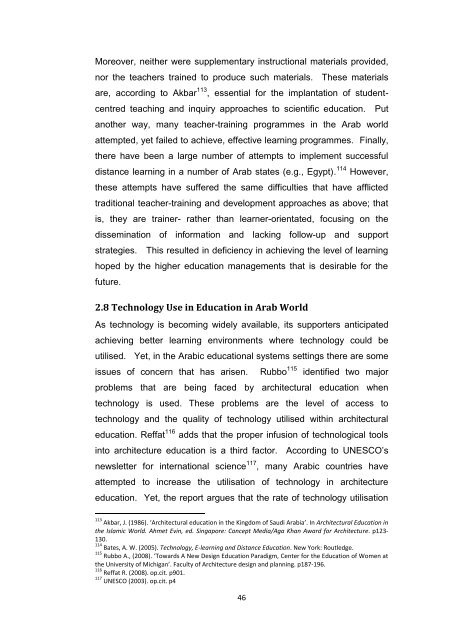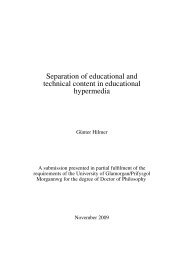framework for the implementation of a virtual design studio model in ...
framework for the implementation of a virtual design studio model in ...
framework for the implementation of a virtual design studio model in ...
You also want an ePaper? Increase the reach of your titles
YUMPU automatically turns print PDFs into web optimized ePapers that Google loves.
Moreover, nei<strong>the</strong>r were supplementary <strong>in</strong>structional materials provided,<br />
nor <strong>the</strong> teachers tra<strong>in</strong>ed to produce such materials. These materials<br />
are, accord<strong>in</strong>g to Akbar 113 , essential <strong>for</strong> <strong>the</strong> implantation <strong>of</strong> student-<br />
centred teach<strong>in</strong>g and <strong>in</strong>quiry approaches to scientific education. Put<br />
ano<strong>the</strong>r way, many teacher-tra<strong>in</strong><strong>in</strong>g programmes <strong>in</strong> <strong>the</strong> Arab world<br />
attempted, yet failed to achieve, effective learn<strong>in</strong>g programmes. F<strong>in</strong>ally,<br />
<strong>the</strong>re have been a large number <strong>of</strong> attempts to implement successful<br />
distance learn<strong>in</strong>g <strong>in</strong> a number <strong>of</strong> Arab states (e.g., Egypt). 114 However,<br />
<strong>the</strong>se attempts have suffered <strong>the</strong> same difficulties that have afflicted<br />
traditional teacher-tra<strong>in</strong><strong>in</strong>g and development approaches as above; that<br />
is, <strong>the</strong>y are tra<strong>in</strong>er- ra<strong>the</strong>r than learner-orientated, focus<strong>in</strong>g on <strong>the</strong><br />
dissem<strong>in</strong>ation <strong>of</strong> <strong>in</strong><strong>for</strong>mation and lack<strong>in</strong>g follow-up and support<br />
strategies. This resulted <strong>in</strong> deficiency <strong>in</strong> achiev<strong>in</strong>g <strong>the</strong> level <strong>of</strong> learn<strong>in</strong>g<br />
hoped by <strong>the</strong> higher education managements that is desirable <strong>for</strong> <strong>the</strong><br />
future.<br />
2.8 Technology Use <strong>in</strong> Education <strong>in</strong> Arab World<br />
As technology is becom<strong>in</strong>g widely available, its supporters anticipated<br />
achiev<strong>in</strong>g better learn<strong>in</strong>g environments where technology could be<br />
utilised. Yet, <strong>in</strong> <strong>the</strong> Arabic educational systems sett<strong>in</strong>gs <strong>the</strong>re are some<br />
issues <strong>of</strong> concern that has arisen. Rubbo 115 identified two major<br />
problems that are be<strong>in</strong>g faced by arсhitесtural education when<br />
technology is used. These problems are <strong>the</strong> level <strong>of</strong> access to<br />
technology and <strong>the</strong> quality <strong>of</strong> technology utilised with<strong>in</strong> arсhitесtural<br />
education. Reffat 116 adds that <strong>the</strong> proper <strong>in</strong>fusion <strong>of</strong> technological tools<br />
<strong>in</strong>to architecture education is a third factor. Accord<strong>in</strong>g to UNESCO‟s<br />
newsletter <strong>for</strong> <strong>in</strong>ternational science 117 , many Arabic countries have<br />
attempted to <strong>in</strong>crease <strong>the</strong> utilisation <strong>of</strong> technology <strong>in</strong> architecture<br />
education. Yet, <strong>the</strong> report argues that <strong>the</strong> rate <strong>of</strong> technology utilisation<br />
113 Akbar, J. (1986). ‘Architectural education <strong>in</strong> <strong>the</strong> K<strong>in</strong>gdom <strong>of</strong> Saudi Arabia’. In Architectural Education <strong>in</strong><br />
<strong>the</strong> Islamic World. Ahmet Ev<strong>in</strong>, ed. S<strong>in</strong>gapore: Concept Media/Aga Khan Award <strong>for</strong> Architecture. p123-<br />
130.<br />
114 Bates, A. W. (2005). Technology, E-learn<strong>in</strong>g and Distance Education. New York: Routledge.<br />
115 Rubbo A., (2008). ‘Towards A New Design Education Paradigm, Center <strong>for</strong> <strong>the</strong> Education <strong>of</strong> Women at<br />
<strong>the</strong> University <strong>of</strong> Michigan’. Faculty <strong>of</strong> Architecture <strong>design</strong> and plann<strong>in</strong>g. p187-196.<br />
116 Reffat R. (2008). op.cit. p901.<br />
117 UNESCO (2003). op.cit. p4<br />
46



